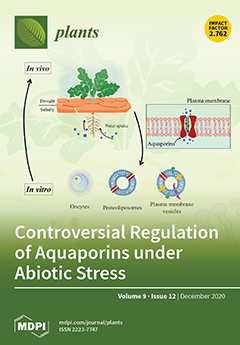The protective effects against drought stress of the endophytic bacterium
Bacillus subtilis 10-4 were measured by studying the priming response in two wheat (
Triticum aestivum L.)—Ekada70 (E70) and Salavat Yulaev (SY)—lines, tolerant and susceptible to drought, respectively.
B. subtilis 10-4 improved germination
[...] Read more.
The protective effects against drought stress of the endophytic bacterium
Bacillus subtilis 10-4 were measured by studying the priming response in two wheat (
Triticum aestivum L.)—Ekada70 (E70) and Salavat Yulaev (SY)—lines, tolerant and susceptible to drought, respectively.
B. subtilis 10-4 improved germination and growth parameters under normal conditions in both cultivars with the most pronounced effect observed in cv. E70. Under drought conditions,
B. subtilis 10-4 significantly ameliorated the negative impact of stress on germination and growth of cv. E70, but had no protective effect on cv. SY.
B. subtilis 10-4 induced an increase in the levels of photosynthetic chlorophyll (Chl) a, Chl b, and carotenoids (Car) in the leaves of cv. E70, both under normal and drought conditions. In cv. SY plants, bacterial inoculation decreased the contents of Chl a, Chl b, and Car under normal conditions, but pigment content were almost recovered under drought stress.
B. subtilis 10-4 increased water holding capacity (WHC) of cv. E70 (but did not affect this parameter in cv. SY) and prevented the stress-induced decline in WHC in both cultivars. Notably,
B. subtilis 10-4 increased endogenous salicylic acid (SA) concentration in both cultivars, especially in cv. E70. Moreover,
B. subtilis 10-4 reduced drought-induced endogenous SA accumulation, which was correlated with the influence of endophyte on growth, indicating a possible involvement of endogenous SA in the implementation of
B. subtilis-mediated effects in both cultivars. Overall,
B. subtilis 10-4 inoculation was found to increase drought tolerance in seedlings of both cultivars, as evidenced by decreased lipid peroxidation, proline content, and electrolyte leakage from tissues of wheat seedlings primed with
B. subtilis 10-4 under drought conditions.
Full article






